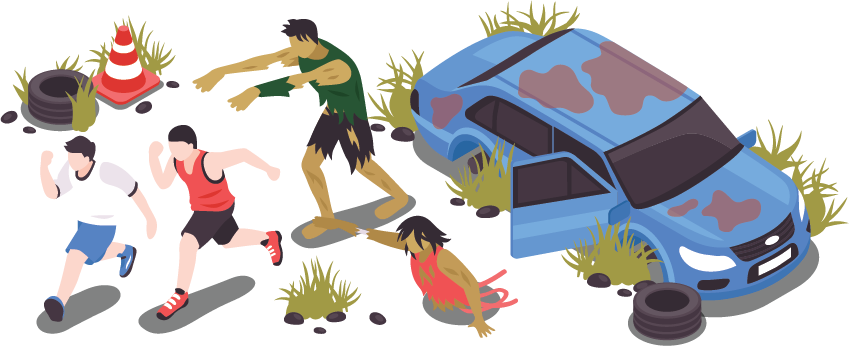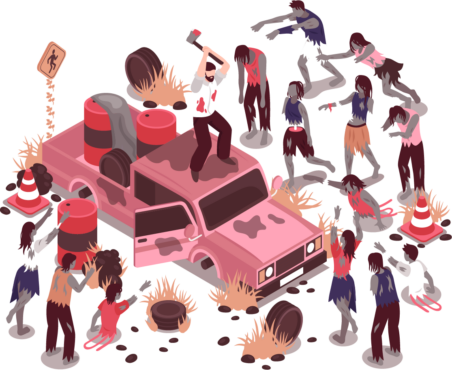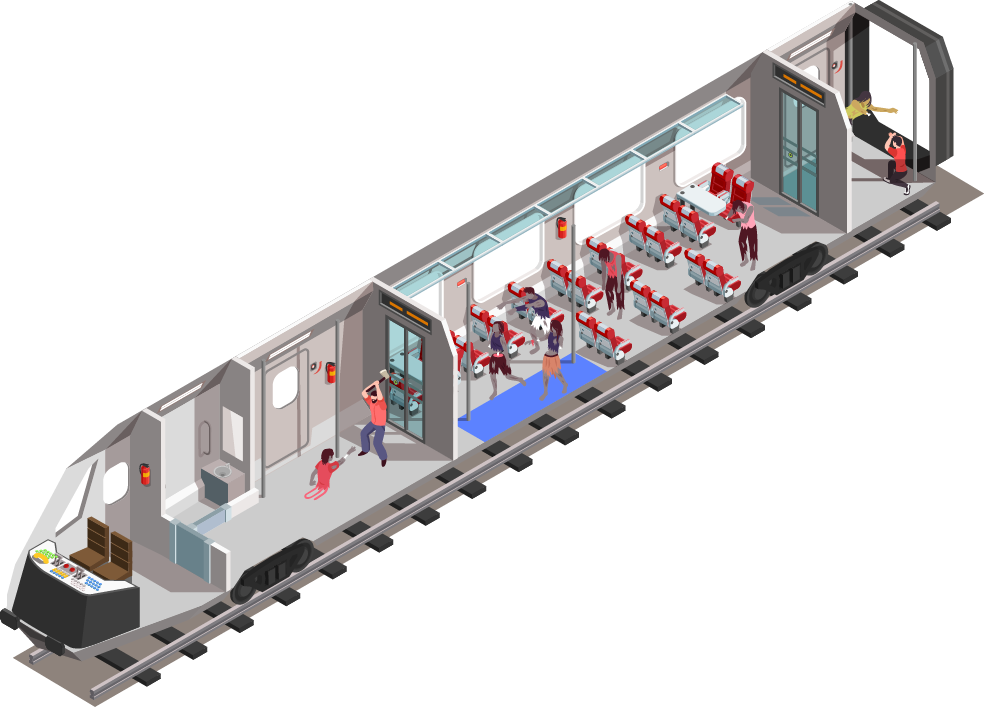Halloween advice: Prepare for the
zombie apocalypse
By Erik English, Thomas Gaulkin
October 30, 2023
A key feature of most zombie fiction is how unexpected the flesh-eating onslaught always is. Communities are caught completely off-guard, and leaders generally find themselves unprepared for the emergency. Society collapses, and the world struggles to learn how to survive in the new reality.
But does the zombie apocalypse have to end this way?
Despite their unlikelihood, zombie threats can be more than just a fictional device. They can serve as a useful metaphor for the challenges that an individual, community, or government may face in a future catastrophe—be it a pandemic, war, or a horde of reanimated corpses feasting on the brains of the living. In 2011, the Centers for Disease Control and Prevention (CDC) embraced the idea in an infamous blog post to help illustrate its emergency preparedness guidance. “You may laugh now,” the blog began, “but when it happens you’ll be happy you read this, and hey, maybe you’ll even learn a thing or two about how to prepare for a real emergency.” It went on to describe strategies for seeking shelter and what supplies to have. The post was so popular the website crashed, leading the CDC to publish a graphic novel on the same theme.
This summer, a semi-serious report on “2023’s Best Cities for Surviving a Zombie Apocalypse” ranked Houston as the most prepared city in the United States, with Miramar, Florida, as the least ready to deal with a Zombie influx. The report draws on statistics like population density, mobility, and availability of resources for protection (like hunting stores), among other factors, to determine each location’s vulnerability. Some large cities like New York and Los Angeles benefit from greater access to resources and escape routes, even though they would need to fight off a larger population of the undead. On the flipside, Detroit fares much worse because of a lack of access to pharmacies and supermarkets.
Scholars are applying more rigorous scientific methods to understand how confronting imaginary zombies can help communities reduce their overall vulnerability to disasters. Athena Aktipis is a professor at Arizona State University and passionate about zombies. She organizes a bi-annual academic conference called the Zombie Apocalypse Medicine Meeting and is the principal investigator for a National Science Foundation-funded project that “combines gamification … with narrative storytelling to develop new strategies for collectively managing risk of natural disasters, infrastructure challenges, pandemics, and other shocks.”

At a recent webinar hosted by the New America think tank, Aktipis and her colleague Coltan Scrivner explained why preparing for the rise of the undead can also make people more prepared for other kinds of emergencies like natural disasters or pandemics. Asked first to define what a zombie is, Atkipis described them as entities that are “fully or partially under the control of another entity.” Zombie mythology traces its roots to the slave trade in the French Caribbean, where slaves who committed suicide were denied a spiritual return to their African home of origin. The zombies were forced to walk the island of their enslavement for eternity, without agency or independence. Later, in the post-colonial context, voodoo sorcerers claimed to bewitch the undead, which they manipulated as free labor performing dangerous tasks. “The very original idea of a zombie as an individual that is somehow hijacked is actually very close to the way that I like to use zombies as both a metaphor and also as a description of things that are actually happening in the world.”
Aktipis pointed out that zombies provide a unique window into society’s emergency preparedness because they can stand in for a variety of social fears. “If we think about zombies as anything that hijacks something else,” Aktipis said, “that could include infectious diseases that hijack their hosts, it could include somebody getting a wrong idea in their head that makes them push the nuclear button. It could include AI takeover … it could include memes that go viral and then polarize society and create a civil war. There's so many things that could happen that could create, you know, real zombies, in that sense.”
The Bulletin has previously explored how recent fictional takes on zombie apocalypse can be a useful metaphor for grappling with social and political order during emergencies and disaster response, especially as relates to the COVID-19 pandemic.

Personal preparedness
The academics’ first recommendation was to have a “shelter-in-place” kit with enough supplies for the first 72 hours or so of a disaster. This includes some of the basics like water and food—the CDC recommends one gallon of water per person per day and a stock of non-perishable items. Aktipis and Scrivner also recommended keeping a set of those items ready in a “go bag,” which could be ready if you need to leave your home unexpectedly in an emergency; the bag should include a first aid kit, a knife, duct tape, work gloves, a good jacket, matches, and physical maps. Aktipis said she would also bring a ukelele.
That last notion might stand out, but some zombies have been shown to have a proclivity for rhythm and dance. Plus, whether you're hiding from the undead or waiting on guidance from authorities during an emergency, it’s possible you’ll have some time to kill. In the video game, The Last of Us, the protagonists often shared a tender moment while playing the guitar.
Notably, phones aren’t a priority item on the go-bag list. (Today, many would argue that smartphones have themselves turned much of the population into zombies.) Communication systems can be overloaded or not function at all during emergencies, so cell phones and the Internet may not be reliable. Taking time to learn how to orient oneself using a physical map instead of a phone could provide life-saving knowledge.

Infrastructure
Aktipis said the next concern is the broader community’s preparedness, including trust in the government agencies and law enforcement who might be responsible for coordinating activities during a disaster. "You can start to sort of look outside of households and say, okay, how is the infrastructure?” she said. “Like, how would people be able to get to a safe place, if they needed to leave their homes? Would they be able to walk? Would they be able to bicycle, would they be able to drive?” (It’s a good idea to have at least a half-tank of gas in your car at all times.)
Public transportation may not be an option if the electric grid has collapsed or if an outbreak has occurred on a train, as in the South Korean film, Train to Busan, which provides a vivid example of what it would be like to share a train with a morning rush of undead commuters.
In fact, the first rule of survival in the 2009 film Zombieland is “cardio,” which makes sense. In a post-apocalyptic zombie hellscape, it seems logical that one would need to occasionally outrun the living dead. Their level of cardio is unclear, and zombie lore tends to disagree on how fast zombies can chase prey. The classic depiction from the George Romero Night of the Living Dead film features slow-moving zombies that amble towards their victims, while more modern iterations like World War Z and 28 Days Later subscribe to the fast zombie model. Still, the lesson rings true: when the dead rise, be ready to run. According to the zombie city rankings, Bellevue and Seattle, Washington, have the lowest physical inactivity rate and are best positioned to have citizens that can outrun a zombie attacker.
Aktipis and Scrivner noted it’s important to become familiar with your community’s emergency plans. If there is a park or other location where citizens should take refuge, know where it is and how to get there. Having a city or community that is prepared for a zombie apocalypse can also help to prevent a mad rush to hoard resources—as in the first months of the Covid-19 pandemic—and avoid societal breakdown.
Crawling toward emergency preparedness
In addition to his work with Aktipis at Arizona State University, Scrivner is the director of the Eureka Springs Zombie Crawl, held annually around Halloween. Described as “a social experience in which a large group of people dresses up like zombies and ‘creep’ from one part of a town to another,” the event gathers zombie “walkers” who parade, very slowly, through the streets, while zombie “hunters” follow along.
The Eureka Springs event, like other zombie crawls around the country, is first and foremost a fun Halloween-themed party. But Aktipis and Scrivner are interested in how it can be leveraged to inspire people to think about management of collective risk without the stress involved in planning for real disasters.
“When it comes to considering what would we do in a flood or in a wildfire, if there was an earthquake—those things can be very scary and almost triggering to even just imagine,” she said. “But … what if it was a zombie apocalypse? Where the zombies had features that actually set up a scenario that's like it would be if there was a wildfire? You can … create these scenarios that then let you think through how you would deal with certain things in a playful way without necessarily having that fear response of imagining something genuinely horrific happening to your neighborhood.”
Aktipis and Scrivner hope events like the zombie crawl can serve as jumping off points to get people asking how they would confront disasters, and taking steps to get their shelter-in-place kits together. According to Aktipis’ Zombified Media site, this year’s crawl will be followed for the first time by a travelling “Apocalypse Road Show” that addresses the question head on: “Could your city survive the zombie apocalypse?”
In his novel, World War Z: An Oral History of the Zombie War, Max Brooks says “Most people don’t believe something can happen until it already has. That’s not stupidity or weakness, that’s human nature.” While many people are more primed to prepare for sudden disruptions to their lives after the COVID-19 pandemic, it’s worth asking what other kinds of disasters we should be prepared for. The relative uncertainty posed by climate change means that one should generally be prepared for anything. It may seem silly to prepare oneself for something like flesh-eating ghouls roaming the country, but better safe than sorry.
“For a gazelle to learn about its local predator, it's kind of costly,” Scrivner said. “You’re putting yourself at risk of being preyed upon. But for a human to do it, you know, we can sit in the comfort of our home and watch it on TV.” (Or read it in the Bulletin.) “There’s really no cost to us. But the learning benefits are still there.”
Header image edited by Erik English, via Casoalfonso / Adobe
Keywords: emergency preparedness, halloween, zombie apocalypse, zombies
Topics: Biosecurity, Special Topics


Interesting and thoroughly relevant in today’s world. Could see some parellels between what you’ve written about and when COVID-19 started to spread – having resources to shelter-in-place and/or leave the city was quite advantageous especially considering people (anecdotally) expected much more pandemonium in the first few weeks of lockdowns.